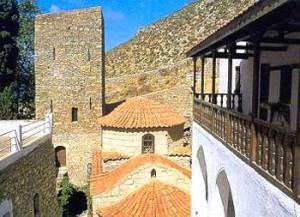
... It is certainly not the most attractive part of the island, but you do have to arrive here by boat. There is a pebbly beachfront around the bay, but there is better swimming to be found northwest and south of the capital.
The capital of the island, Megalo Horio (which means big village) is 8 kilometers northwest of the port and with a high elevation. It stands framed in the background by the hill with the remains of the ancient fortress, the Castle of the Knights, standing guard. This is the site of the original capital of the island in medieval times, and you can view the remains of fortress walls, houses, chapels, and the church of the Archangel built on the ruins of a temple. The church has some frescoes still visible, and the view from the top of the fortress is outstanding. Also in the capital, there is a small museum displaying the bones from the dwarf elephants that once lived on the island, more than 6 million years ago. The town is very traditional, with just a couple of tavernas, a kafenion, and a few accommodation choices; more like a small village, rather than an island capital!
There is a public bus that runs between the port and the capital, and connects to the beach of Eristos, about three kilometers south of the capital. This is a pretty sandy beach with a taverna. The bus also calls in at Ai. Antonios on the north coast, then continues west, then south along the coastal road terminating at the Monastery of St. Pantaleimon. The monastery dates to the 15th century and has a beautiful pebble courtyard, and is known for its miraculous spring. Its location on the coast, approximately 200 meters above the sea, offers an incredibly beautiful panoramic view. On the bus route taking you to the monastery, just after Ai. Antonios, you can ask the bus driver to stop and let you off near the beach of Plaka, which is a very fine sandy beach (bring your own picnic for this beach). Tilos also boasts of at least six caves which you can explore. There is a good walking map available locally, and there are quite a few chapels and monasteries worth looking at south and west of the port. You can also walk from the port to the now abandoned town of Mikro Horio (small village), which was once home to more than 1,200 inhabitants.
Historically, it is a very interesting island, though one that has fallen into slow decline in the last century. It is primarily noted for the discovery of the bones of the dwarf elephants, which roamed the island 6 million years ago, while the island was still a part of Asia Minor. The presence of man dates to the Neolithic period. As is true of other nearby islands, finds attest to the presence of the Minoans, Myceneans, and Dorians. The Romans reigned from 42 B.C. until the Byzantine period when, together with Nisyros, Kos, and Samos, it constituted the Samos Issue. In 1310 the island was taken over by the Knights of St. John. In 1522, the Turks successfully took the island, after many attempts, and they stayed until the Italian occupation, which began in 1912. From the time of the Italian occupation and well beyond 1948, when Tilos was officially joined with Greece, emigration continued to occur, and the island population fell to its more or less present levels. Today, the island supports itself through farming, animal husbandry, fishing, and tourism. It is not a fertile island, however, having only one substantial fertile valley lying between the capital and the beach at Eristos.
Tilos is the homeland of the poetess Irinna, who lived in 350 BC and is considered something between a tenth Muse and a female Homer.



